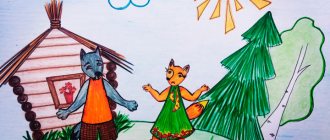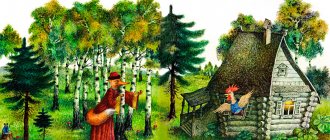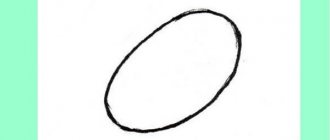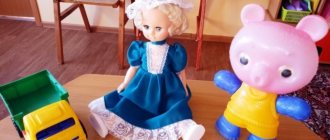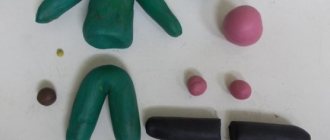Literary living room (poetry library)
So in everything, whatever you want people to do to you, do so to them, for this is the law and the prophets. Bible, New Testament: Gospel of Matthew (Matthew 7:12)
Portrait of La Fontaine Jean de La Fontaine Hyacinthe Rigaud circa 1684
Today the program includes the fable “The Fox and the Stork” by the famous French fabulist Jean de La Fontaine , the painting “The Fable of the Fox and the Heron” by the Flemish painter Frans Snyders , the Russian folk tale “The Fox and the Crane” processed by the outstanding researcher and collector of folklore Alexander Nikolaevich Afanasyev and illustrations for this wonderful fairy tale performed by Alexey Nikanorovich Komarov and Evgeny Mikhailovich Rachev .
The fable “The Fox and the Stork” by La Fontaine in an extremely masterly poetic form illustrates the “Golden Rule of Morals” which states: Treat people the way you want them to treat you. The negative formulation of this rule is also known: Do not do to others what you do not want for yourself.
Hyacinthe Rigaud (07/18/1659–12/29/1743) - French painter, master of ceremonial baroque portraits of the times of Louis XIV and Louis XV.
And also... I invite readers of the green pages to plunge into the treasure trove of native Russian wisdom - to pamper themselves with Russian proverbs and “translate” La Fontaine’s fable into the capacious, powerful and incredibly figurative Russian language
- As it comes back, so will it respond.
- What is hello, so is the answer.
- What goes around comes around.
In my opinion, this magnificent trio of Russian folk proverbs most effectively accumulates the essence of Jean de Lafentin’s fable “The Fox and the Stork” .
THE FOX AND THE STORK – A FABLE BY JEAN DE LAFONTAINE Le Renard et la Cigogne
The fox, stingy by nature, suddenly decided to be known as a hospitable one. But how can you be so as not to involve yourself in unnecessary expenses? The question is tricky - not everyone can solve it, But for the fox such a question is a trifle: The cheat made some liquid porridge, put it thinly on a dish, and most importantly calls the stork for lunch. A neighbor appears when called, and both begin to eat the served dish. Well, porridge, whatever! The only bad thing is that the stork is not used to eating like this: He pokes and pokes into the dish with his nose, But not a crumb gets into his beak; Meanwhile, the little fox, in one moment, licked up all the porridge with her tongue. Here the stork, in turn, to punish the fox, and partly for fun, invites her to dinner tomorrow. He fried the meat, cooked seasonings for it, chopped it into small pieces and put it in a narrow jug. Meanwhile, the fox, sensing the smell of meat, came hungry, barely waiting for an hour, and well, let’s fuss and fuss around the table and marvel at the neighbor’s generosity. But flattery did not help her here: The jug fit the stork’s beak, The guest’s muzzle was too round... And the greedy godfather, with nothing, just as she came, With her tail between her legs, she retreated into her hole. Borrowed from Phaedrus.
Jean de La Fontaine (07/08/1621–04/13/1695) - French poet, writer, fabulist. Phaedrus (Phaedrus; c. 20 BC in Macedonia - c. 50 AD) - Roman poet and fabulist. He translated Aesop's fables and imitated them.
The fox wanted to be known as a hospitable hostess, and at the same time have a great dinner with the stork, but she cruelly miscalculated. I didn’t expect that the stork would repay her in the same coin - what goes around comes around.  Whatever the fox sowed, so she supped for the coming sleep, only left the hungry and bitter drools for herself.
Whatever the fox sowed, so she supped for the coming sleep, only left the hungry and bitter drools for herself.
The Fox and the Crane: Balabolka Stories
Fox, crane and hare. They go by bus. The bus stops and a guy gets out. The driver says: “I won’t take you, you need to get out.” Everyone comes out. And the guy gets on the bus. Crane: - Sit down, guy. Guy: - I won’t sit down. I know you, fox, you led me. - Oh, what are you talking about! - Sit down, they tell you. …….. The fox asked the crane: “Are you the smartest in the owl? I always thought you were very wise!” "no, I'm just cunning." Fox. “And you are very cunning,” said the Crane. - “I know what to do!” He flew off into the thickets, and a few minutes later returned with a small fox. The crane said: “Fox, you two will keep watch near the hole. …….. They are friends, but every day the fox goes hunting. And then one day the fox saw a crane and thought: “I’ve always wondered what a crane tastes like.” And she ran into the forest, caught a crane, brought it to her home and said to her mother: “Mom, let’s make soup out of it!” - No need, daughter, he’s so small. - But it’s very tasty, I tried it. ………. The fox, in order to catch the crane, decided to set a trap for it - she built a bridge across the swamp and began to wait for the crane at its crossing. Soon the crane saw a fox who was luring him into a trap. He began to think: “The fox is building such a big bridge, does she really think that I will cross the swamp?” And he did not cross the swamp. Instead, he jumped over to the other side and disappeared into the forest. ………. - Fox, look how beautiful the crane is! - said the crane, looking at the fox. - Yes, very beautiful, but disgusting, disgusting and harmful! - the fox answered, looking at the crane. ………. One day, a fox, flying over a swamp, noticed a crane, which, noticing her, took off in fright. - That's what I understand, tough guy! - said the fox. And the crane had to pee on a tree to get down. When a day later he flew over this place again, he saw that the tree was again covered in urine. The fox decided that this was fate and also began to live in the swamp. ……… The Fox got ready to go hunting and lay down to take a nap, and the Crane said to her: “You’re crazy!” Can't you see how dark it is here? - And I’m doing it from memory! - answered the fox. - How is that? - Crane was surprised. Then the fox remembered and said to him: “Listen, Crane!” I have a memory like a fish, only I can remember everything that has happened to me since childhood. …….. Once upon a time there lived a Fox. And she wanted to fly. The Fox took off and flew. I flew for a day, then another. On the third day he sees a crane sitting in the window, looking at the Fox with sad eyes. - What are you watching? - asked Lisa. “I’m bored...” “But I’m thinking,” said the Fox, “how to make a stuffed animal out of you, so old, and hang it on the Christmas tree.” The crane was not at a loss. ……….. Fox asks: “Do you love me?” The crane replies: “Always!” The fox says: “I’ll now climb a tree, and you’ll eat me.” The crane has nowhere to go, he agrees. The fox climbs a tree. The crane could not stand it, broke loose and fell. He flew over the fox and said: “If you love me, take me back!” “With pleasure,” answered the fox. Transferred. ………. One day, the cranes flew south and the fox flew with them. For a long time she flew after the cranes to take her place in their flock, but the crane chased her away. And as soon as the crane agreed, the fox took his place. So she flew from crane to crane until she got tired and fell behind. She flew in and began to watch for the crane to take her place in the flock. …….. The fox, like most animals, is very good at pretending. She pretended to be thirsty and slowly ate the crane. But when the fox realized that she had been exposed, she pretended to cry so that the crane would come running to her. And of course, she ate it. So the crane remained alive. In the end, the Fox ate her husband. ……… At the beginning everything goes well. You are completely absorbed by the fox, but suddenly he disappears into the bushes. Now you're trying to keep up with the crane. But the fox ran into the same bushes again and now the cranes are looking at you. What is it for? This happens during a thunderstorm. ……… The fox asked if she and the crane could fly up the tree. It was difficult for the cranes to explain to people like the fox that they did not fly. And then the crane said: “There are some things on earth that you cannot understand, but there are also things that you simply should not touch.” ……… In ancient times, even before people learned to make dishes from clay, a cunning fox lived in the forest. He declared about himself that he is the best master in this matter. He walked through the forest for a long time, offering his clay products to all the animals and birds. Everyone laughed at the fox, except for one crane, who not only bought his products, but also taught the fox various tricks. Since then, the fox has gained fame as a skilled potter. ………. The fox jumps and shouts: “I caught the crane, I caught the crane!” The crane also jumps and, trying to catch the fox, shouts in response, how did she catch it! They jumped like this for several days, but then the fox finally caught the crane. And after they had both calmed down, the crane asked the fox: “How many children have you?” “I have no children,” answered the fox. …….. The fox saw a crane standing on one leg. "What about him?" - asks the fox. “When it stands on one leg, it takes up the entire volume in the wings,” explains the crane. When the fox realized this, she began to use this ability in her flights. Now, when the fox flies, its wings occupy the entire volume in the wings. Lisa was very proud of this! ………. They have been together for several years, and she still can’t make up her mind to cross his path. And then one day the fox sees that the crane is about to take off and says: “I’ll cross your path.” The crane agreed and the fox quickly crossed his path. But as soon as the fox began to run, the crane rose into the air and flew after her. Then the fox stopped, waited a little and said again: “I’m crossing your path!”
“THE FABLE OF THE FOX AND THE HERON” – PAINTING BY FRANS SNYDERS
|
Frans Snyders (11.11.1579–19.08.1657) – Flemish painter, master of still lifes and animal compositions in the Baroque style.
In the painting by Frans Snyders “The Fable of the Fox and the Heron” , unlike La Fontaine’s fable, the winged and long-nosed character is not a stork, but a beautiful heron with her husband ;-), and the treat for the fox is delicious, sparkling with silver scales, live fish in a transparent jug . And the fox’s mouth is watering, looking at the fish, but he can’t get her a treat... So the essence of the fable is still the same: What is the greeting, is the answer .
THE FOX AND THE CRANE – RUSSIAN FOLK TALE
The fox and the crane became friends, even had sex with him in someone’s homeland. So one day the fox decided to treat the crane and went to invite him to visit her. - Come, kumanek, come, dear! How can I treat you! The crane is going to a feast, and the fox made semolina porridge and spread it on the plate. She served it and treated it to her: “Eat, my little darling!” I cooked it myself. The crane slammed his nose, knocked, knocked, nothing hit! And at this time the fox was licking and licking the porridge, so she ate it all herself. The porridge is eaten; The fox says: “Don’t blame me, dear godfather!” There is nothing else to treat. - “Thank you, godfather, and that’s it!” Come to visit me. The next day the fox comes, and the crane prepared okroshka, put it in a jug with a small neck, put it on the table and said: “Eat, gossip!” Really, there’s nothing else to regale you with. The fox began to spin around the jug, and he would come in this way and that, and lick it, and sniff it, but he wouldn’t get anything! My head won't fit into the jug. Meanwhile, the crane pecks and pecks until it has eaten everything. - Well, don’t blame me, godfather! There is nothing more to treat. The fox got annoyed, thought that he would eat enough for a whole week, and went home as if he had eaten nothing. As it came back, so it responded! Since then, the fox and the crane have been apart in their friendship. Recorded in the Tver province “Russian folk tales” , first published thanks to the historian and literary critic Alexander Nikolaevich Afanasyev .
Alexander Nikolaevich Afanasyev (07/23/1826–10/05/1871) - Russian collector of folklore, researcher of the spiritual culture of the Slavic peoples, historian and literary critic. The special merit of Alexander Nikolaevich Afanasyev is the compilation of the collection “Russian Folk Tales” (1855–1864), which includes about 600 texts.
And in conclusion, two illustrations for the Russian folk tale “The Fox and the Crane” performed by Soviet animal artists Alexey Nikanorovich Komarov and Evgeny Mikhailovich Rachev .
| The Fox and the Crane – Russian folk tale
|
The crane is going to a feast, and the fox made semolina porridge and spread it on the plate. She served it and treated it to her: “Eat, my little darling!” I cooked it myself. The crane slammed his nose, knocked, knocked, nothing hit! And at this time the fox was licking and licking the porridge, so she ate it all herself.
| The Fox and the Crane – Russian folk tale
|
The next day the fox comes, and the crane prepared okroshka, put it in a jug with a small neck, put it on the table and said: “Eat, gossip!” Really, there’s nothing else to regale you with. The fox began to spin around the jug, and he would come in this way and that, and lick it, and sniff it, but he wouldn’t get anything! My head won't fit into the jug. Meanwhile, the crane pecks and pecks until it has eaten everything.
Komarov Alexey Nikanorovich (1879–1977) - Russian and Soviet animal artist, considered the founder of the Russian animalistic school. Alexey Nikanorovich Komarov illustrated scientific and children's books, created drawings for stamps, postcards, and visual aids. Several generations of children grew up learning from textbooks with his wonderful drawings.
Rachev Evgeny Mikhailovich (1906–07/02/1997) - Russian and Soviet animal artist, one of the most popular children's illustrators of the last century. Honored Artist of the RSFSR. Evgeny Mikhailovich Rachev devoted his entire creative life to children's books, turning ordinary animals and birds into fairy-tale characters.
§ I invite readers to look at the green page “Biophysics: Legs, tails... most importantly... - ears!” We bring to your attention luxurious biophysics - educational interesting things (the adaptation of animals to different temperatures), as well as wonderful illustrations: an incomparable red-haired beauty, the immortal heroine of delightful Russian folk tales - an ordinary or red fox in the paintings of animal artists: Alexei Nikanorovich Komarov and Evgeniy Mikhailovich Rachev.
Cat Basilio
[25.07.2018, 00:07]
I wonder, have the deputies of the State Duma read La Fontaine’s fable “The Fox and the Stork”? With the pension reform, they have every chance to fly! As it comes back, so will it respond!
Leila
[25.07.2018, 15:57]
Very interesting material. You made a great trio! By the way, the golden rule of morality is not found in the Koran, but it is simultaneously interpreted positively and negatively in the Sunnah as one of the sayings of Muhammad, who taught the highest principle of faith: “Do to all people what you would like them to do to you.” people, and do not do to others what you would not wish for yourself.”
POETIC LIBRARY OF GREEN PAGES
§ Autumn poetry by Ivan Alekseevich Bunin and the painting “Andreich” by Alexei Nikolaevich Liberov
§ “Autumn Elegy” by Alexander Alexandrovich Blok and the painting “Autumn (Siberian Autumn)” by Alexey Nikolaevich Liberov
§ Nostalgia: Alma-Ata, my Alma-Ata... A song about my beloved, one and only Alma-Ata - the incomparable capital of my youth... performed by Kazakh opera singer Alibek Dnishev
§ The poem “Bless every work, good luck!” Sergei Aleksandrovich Yesenin and Soviet paintings dedicated to the heroes of labor
§ The poem “In Memory of a Friend” by Anna Andreevna Akhmatova and paintings from the Great Patriotic War
§ The poem “Dog” by Vladimir Grigorievich Kalinichenko and the painting “Motley Dog” by Alexey Nikanorovich Komarov
§ Ancient Russian romance “The Night is Bright” and the painting “Moonlit Night” by Ilya Efimovich Repin
§ The poem “Among the Flat Valley” by Alexei Fedorovich Merzlyakov and the painting “Among the Flat Valley...” by Ivan Ivanovich Shishkin
§ The poem “Alatau” by Dzhambul Dzhabayev and a series of paintings “In the Alatau Mountains” by Vasily Vasilyevich Vereshchagin as well as... a fascinating journey through Alatau with paintings by contemporary artist Alexander Vasilyevich Nemakin
with paintings by contemporary artist Alexander Vasilyevich Nemakin
§ The poem “In the wild north stands alone...” by Mikhail Yuryevich Lermontov and the painting “In the wild north...” by Ivan Ivanovich Shishkin.
§ The poem “The Mill” by Vladislav Felitsianovich Khodasevich and the painting “The Old Mill” by Pavel Pavlovich Dzhogin
§ The poem “Birch” by Vsevolod Aleksandrovich Rozhdestvensky and the painting “Birch Grove” by Isaac Ilyich Levitan
Read the fairy tale “The Fox and the Crane”
The fox and the crane became friends. So one day the fox decided to treat the crane, and went to invite him to visit her: “Come, little kuman, come, dear!” How I can treat you!
The crane is going to a feast, and the fox made semolina porridge and spread it on the plate. Served and treated: - Eat, my darling kumanek! I cooked it myself. The crane knocked and knocked with his nose, knocked and knocked on the plate, nothing hit. And at this time the fox is licking the porridge for itself and licking it all off itself.
The porridge is eaten; The fox said: “Don’t blame me, dear godfather!” There is nothing more to treat! - Thank you, godfather, and that’s it! Come and visit me now. The next day the fox comes, and the crane prepared okroshka, put it in a jug with a small neck, put it on the table and said: “Eat, gossip!” True, there is nothing more to treat.
The fox began to spin around the jug, and would come in this way and that, and lick it and smell it; nothing is enough! My head won't fit into the jug. Meanwhile, the crane pecks and pecks until it has eaten everything.
- Don't blame me, godfather! There is nothing more to treat. The fox was annoyed: she thought she could eat enough for a whole week, but she went home hungry. As it came back, so it responded. Since then, the fox and the crane have been apart in their friendship.
More on the topic: Goby, tar barrel ∼ Russian folk tale
